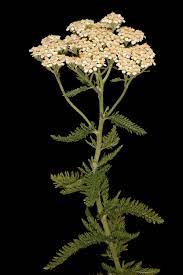Yarrow

Yarrow, scientifically known as Achillea millefolium, is a versatile and well-known herb that has been used for various purposes throughout history. Here’s some information about yarrow and its uses:
- Botanical Description:
- Yarrow is a perennial plant native to Europe, Asia, and North America.
- It typically grows to a height of 1 to 3 feet (30 to 90 cm).
- Yarrow has feathery, finely divided leaves and produces flat-topped clusters of small, white or pinkish flowers.
- Historical Uses:
- Yarrow has a long history of medicinal use, dating back to ancient times. It was used by various cultures, including the Greeks and Native Americans, for its healing properties.
- The genus name “Achillea” is derived from the Greek hero Achilles, who was said to have used yarrow to treat the wounds of his soldiers during the Trojan War.
- Medicinal Uses:
- Yarrow has astringent, anti-inflammatory, and antimicrobial properties, making it useful for treating various health conditions.
- It has been traditionally used to stop bleeding, both externally (as a poultice) and internally (as a tea).
- Yarrow is believed to have mild pain-relieving properties and has been used to alleviate minor discomfort.
- It is often used as a remedy for digestive issues and is said to stimulate the appetite and ease indigestion.
- Yarrow tea is used as a diuretic and is believed to help with urinary tract health.
- Some people use yarrow to relieve symptoms of the common cold and flu.
- Culinary Uses:
- Yarrow leaves and flowers can be used as a culinary herb. They have a slightly bitter and aromatic flavor.
- Yarrow can be used to season soups, stews, salads, and as a garnish for various dishes.
- The young leaves are considered the most palatable for culinary purposes.
- Ornamental Use:
- Yarrow is also grown for its ornamental value due to its attractive, feathery foliage and colorful flowers. It can be a great addition to gardens and landscaping.
- Other Uses:
- Yarrow has been used in the production of natural dyes for textiles, giving a range of colors from yellow to green.
- It has been employed in traditional rituals and folklore for various purposes, such as divination and love charms.
- Yarrow can be a valuable plant in regenerative farming practices for several reasons. Regenerative farming aims to improve soil health, increase biodiversity, and promote sustainable agriculture. Yarrow can contribute to these goals in various ways:
- Dynamic Accumulator: Yarrow is known as a dynamic accumulator, meaning it can draw up nutrients and minerals from deep within the soil with its long taproot. When the plant is cut back or mulched, these accumulated nutrients are returned to the surface and made available to other plants, improving overall soil fertility.
- Pollinator Attraction: Yarrow’s abundant, nectar-rich flowers attract pollinators like bees and butterflies. By increasing pollinator activity, yarrow can support the pollination of other crops in the area, leading to improved yields.
- Natural Pest Control: Yarrow is believed to repel certain pests, such as aphids, due to its aromatic compounds. Planting yarrow near vulnerable crops can help deter pest infestations and reduce the need for chemical pesticides.
- Soil Stabilization: Yarrow’s extensive root system can help prevent soil erosion by stabilizing the soil structure. This is especially beneficial in areas prone to erosion, such as sloping fields.
- Companion Planting: Yarrow can be strategically planted alongside other crops as a companion plant to offer benefits like nutrient cycling, pest control, and increased resilience.
- Medicinal Plant Production: Yarrow can be grown as a cash crop for its medicinal properties. It has the potential to generate income for regenerative farmers while supporting holistic farm practices.
- Wildlife Habitat: The presence of yarrow can contribute to increased biodiversity on the farm by providing a habitat for beneficial insects and other wildlife. This, in turn, helps maintain a balanced ecosystem.
- Drought Tolerance: Yarrow is known for its drought resistance, making it a resilient plant in areas with limited water resources.
- Soil Health Improvement: Yarrow’s decomposition and nutrient return to the soil when used as mulch or cover crop can help enhance overall soil health and structure.
- Cultural Uses: Some traditional farming practices, such as biodynamic farming, incorporate yarrow as part of their soil preparations and crop management rituals.
It’s important to note that while yarrow has a history of use for medicinal and culinary purposes, you should exercise caution and seek professional advice before using it for any specific health-related issues. Always consult with a healthcare practitioner or herbalist for guidance on its proper usage and potential side effects, especially if you are pregnant, nursing, or taking other medications.
